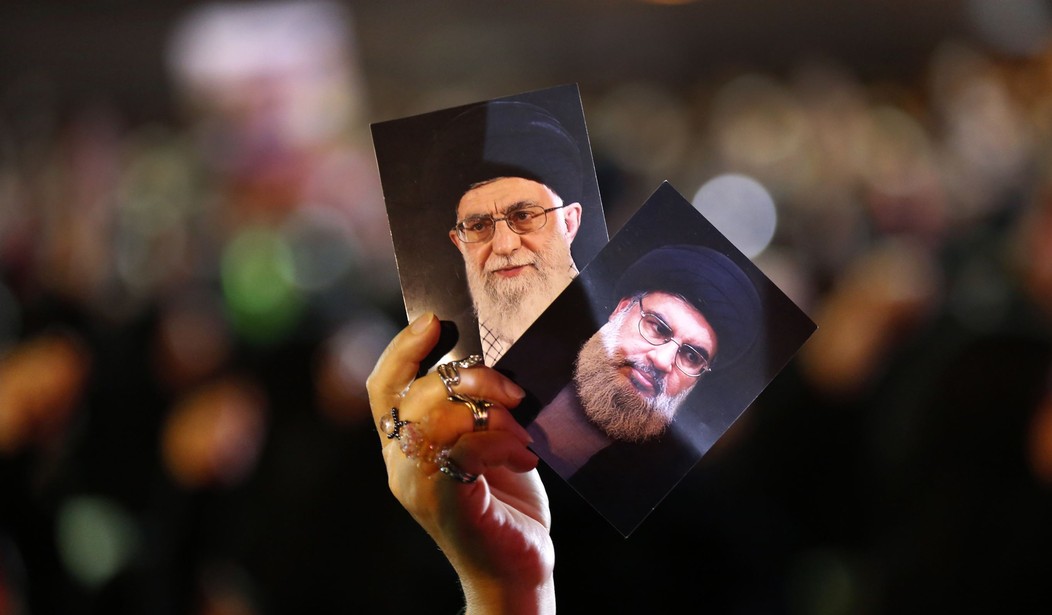The killing of Hassan Nasrallah and the entire Hizballah high command, followed almost immediately by the killing of Nasrallah’s designated successor Hassan Khalil Yassin, could mean the end of Hizballah as a force to be reckoned with in Lebanon. Nasrallah’s death also strikes a serious blow to the Islamic Republic of Iran’s decades-long effort to gain hegemony over the entire Middle East.
Back in 2015, Iran’s Supreme Leader, the Ayatollah Ali Khamenei, explained that once Israel is destroyed, “the West’s hegemony and threats will be discredited” and “the hegemony of Iran will be promoted.” Iran had been working for years to promote that hegemony through a series of allies, clients, and proxies across the Middle East, Hizballah being the chief among them.
In fact, the assembly of the “Shi’ite crescent” began in Lebanon. As The Complete Infidel’s Guide to Iran explains, Hizballah (“Party of Allah”) rose to prominence during the Lebanese civil war of the early 1980s. Hizballah was an Iranian proxy from its inception, as the U.S. Supreme Court recognized when it ruled that Iran was liable for payments to the families of the victims of Hizballah’s 1983 bombing of the U.S. Marine barracks in Beirut, in which 241 Americans were killed. Indeed, Hizballah began at a meeting in Tehran between the Ayatollah Khomeini and a delegation of Lebanese Shi’ites, including Hassan Nasrallah.
At this meeting, Khomeini gave his approval to the creation of Hizballah as a competitor to the dominant Lebanese Shi’ite group, the Amal Movement, whose leader, Musa Sadr, opposed the idea of clerical rule that was the guiding principle of the Islamic Republic. Khomeini gave Shiekholislam Seyyed Ali Khamenei, who would later succeed him as Iran’s Supreme Leader, the task of supervising the establishment of Hizballah. According to Nasrallah, Iran “offered Lebanon everything in its power: money, training, and advice.”
In a February 1985 “Open Letter,” Hizballah associated itself with Iran’s Islamic Revolution: “We are the sons of the umma (Muslim community)—the Party of God (Hizb Allah) the vanguard of which was made victorious by God in Iran. There the vanguard succeeded to lay down the bases of a Muslim state which plays a central role in the world.” The letter maintained that Hizballah’s political program was simply an outgrowth of its commitment to Islam: “As for our culture, it is based on the Holy Koran, the Sunna and the legal rulings of the faqih [an Islamic jurist; in this case, Khomeini] who is our source of imitation (marja’al-taqlid). Our culture is crystal clear. It is not complicated and is accessible to all.”
Given Iran’s intense hatred for the U.S. and the Iranian derivation of the group, it is not surprising that Hizballah became internationally notorious for the October 23, 1983, bombing of military barracks in Beirut. Hizballah also won notoriety for its jihad suicide bombing at the U.S. Embassy in Beirut on April 18, 1983, which killed 63 people, including 17 Americans. Hizballah continued its actions against the United States by kidnapping the CIA station chief in Lebanon, William Buckley, on March 16, 1984. Buckley’s captors subsequently delivered several videos to American embassies showcasing how they were torturing him. After viewing the first, CIA director William Casey said: “I was close to tears. It was the most obscene thing I had ever witnessed. Bill was barely recognisable as the man I had known for years. They had done more than ruin his body. His eyes made it clear his mind had been played with. It was horrific, mediaeval and barbarous.”
Although it became feared and loathed by targeting Americans, Hizballah’s chief mission is to be the Lebanese extension of the Islamic Republic’s fanatical hatred for Israel, pressing Israel from the north while Hamas, a Sunni group that was also funded from Tehran, pressured it from the south.
Related: Terror Gets Rewarded: ‘State of Palestine’ Takes Seat in UN General Assembly
Yet now Hamas has been decimated and Hassan Nasrallah is dead. Is Iran’s dream of a “Shi’ite crescent” dead with it? By any reasonable calculus, the future of the Islamic Republic doesn’t look nearly as bright as it did as recently as a year ago.
There is, however, one wild card that could keep alive Iran’s hopes of regional hegemony and the destruction of Israel: the Biden-Harris regime. Back in Nov. 2023, almost immediately after Iran-funded Hamas massacred 1,200 Israelis, Old Joe Biden and Kamala Harris issued a sanctions waiver that enabled the Islamic Republic to claim $10 billion. If Kamala is elected president, the American gravy train to Tehran will likely continue running, enabling the mullahs to continue their jihad against Israel and maintain their hopes of becoming the region’s dominant power. They’ll scream “Death to America” all the way to the bank.










Join the conversation as a VIP Member